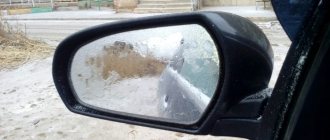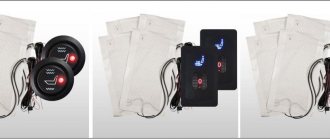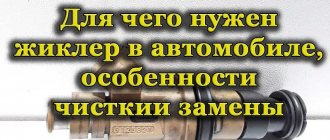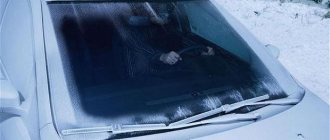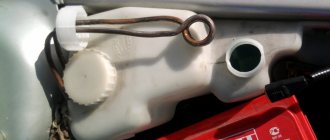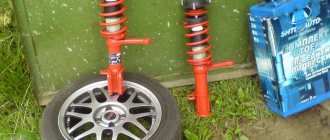Bad weather, when it snows or rains outside, is often accompanied by fogging of windows and mirrors and the formation of ice on them. Snow sticks, water partially freezes, which negatively affects the driver’s visibility.
And you need to constantly and very carefully monitor the road situation. The driver needs to watch not only what is happening in front of him, but also be aware of what is happening behind him.
For many, heated mirrors may seem like a practically useless solution. Others believe that they cannot do without it.
If the car owner is unlucky and does not have standard heating, you can always install the system yourself.
Why do you need heated mirrors?
Before installing an effective heated mirror on your car, it is worth talking about its necessity and benefits.
There are several reasons why car companies install these systems on many cars from the factory, and owners of old cars decide to install them on their own:
- Safety. This is the main aspect and the main reason. Heating provides a better view of what is happening behind, since the driver constantly uses the internal and external rear-view mirrors while driving. And if heating is not needed inside, then outside it is a necessity.
- Comfort. The driver will not have to be distracted by lowering the side window and wiping the mirror. Heating will independently remove water and dry out excess moisture.
- Anti-fog protection. During humid weather, condensation may actively form on the exterior mirrors. It blocks normal visibility.
Heating is needed to improve traffic safety and provide good visibility.
Alas, many older machines do not have this function from the factory. But there is a way out of the situation. This is a DIY system installation.
Types of heating systems
There are several types of systems that are installed on exterior mirrors. Each of them has its own characteristics.
The first versions of such units were extremely simple. An ordinary incandescent lamp was mounted inside the mirror. It turned on, heating occurred from the inside, which made it possible to melt the ice and partially dry the surface.
The modern heating method has changed, but the principle of organizing the system and its functions have not changed.
There are 3 types of exterior mirror heaters:
- Wire. Wire-based heating is quite common in cars. The heating element here is a tungsten filament. It is laid on a layer of insulation with heat-resistant characteristics. Current from the on-board network passes through the threads, which provokes heating and removal of ice.
- Printed conductors. Cars are equipped with printed circuit conductor systems, which are considered the most modern. You can easily buy such boards and install them yourself. You won't be able to make them yourself.
- Film. A special film heater has a corresponding base, inside of which there are heating elements.
Separately, it is worth highlighting lamp defrosters. This is a fairly outdated technology, but easy to implement. Mainly used by owners of old domestic cars. With minimal investment you can get good heating. It is enough to install and connect a small incandescent lamp of approximately 10 Watts into the mirror body.
Selecting a heating element
Of course, for the most part, the heating elements that are installed inside the side mirrors are the same. However, there are differences in the shape and size of the element itself, so if you yourself cannot say with confidence that this particular element will suit you, it is better to consult the seller, since most often heaters are made for specific car models or for entire lines of cars with mirrors of the same size and shape.
If there is no opportunity to consult, then it is better to buy a heating element slightly smaller in size than the mirror surface itself. In this case, you will protect yourself from an unpleasant situation when you have to trim the heater body, which is fraught with depressurization and burnout of the element during operation.
Also, when purchasing, make sure that the voltage and current indicated on the heating element are suitable for powering from your car battery.
How to install a ready-made kit
Not all motorists know how to install heated mirrors themselves, without having anything at their disposal. Not everyone can assemble a unit from scratch. But for such situations there are ready-made kits. All that remains is to install them correctly, following the instructions.
To organize heating for the side mirrors of a car with your own hands, you usually need to perform the following steps:
- remove the mirror assembly from the car;
- if the body elements are glued together, they can be heated with a hairdryer or filled with hot water;
- bolted connections are simply unscrewed with a suitable tool;
- the part is thoroughly cleaned and dried;
- the internal dimensions of the housing and the heater are compared;
- film heaters can be cut according to special marks;
- wire systems are laid according to the size of the internal space;
- the board will have to be selected to match the dimensions of the rear view mirror housing;
- the board is glued from the inside with heat-resistant glue;
- the films are fixed on the wrong side;
- Wires should be soldered to the contact thermoelements and brought out to the power source.
At this point, the installation of heated mirrors is almost complete. It is not difficult to do it yourself. But it is also important to connect the system for power supply from the mains.
Most often, the connection is made to the line that supplies power to the heated rear window. Some output a separate wire, connect a relay and its own fuse.
It's worth taking a look at the instruction manual. Many cars are equipped with heating from the factory, but it is installed only on expensive trim levels.
This allows, with more modest equipment, to use the factory connection circuits for a standard defroster by connecting a heating element purchased separately.
Electrical circuits and wiring arrangements are different on all machines. Therefore, there cannot be universal connection instructions.
Another option would be to connect a defrosting system assembled from scratch.
A few important details
To disassemble the mirrors, you will need screwdrivers of different sizes, as well as hex keys. You will need to find a place in the car to set the heating to turn on and off.
To disassemble the side window, first loosen the mounting screws. Use a hair dryer to soften the mirror elements. If this tool is not available, the driver can use hot water. The mirror must be completely placed in water, after which the analysis will be much easier.
Important! When dismantling, you must use plastic elements so as not to damage the structure or scratch the glass.
To get the maximum effect from the heating operation, the elements must be prepared so that the contacts do not touch the coating. Contact between heat and coating results in burnout. All work can be done independently. However, it is better to contact a specialist, he will help with installation and perform the correct installation, so that unforeseen situations do not arise during the operation of the mirror heaters.
Installation and assembly must be performed sequentially. Each stage is performed one after another (certain actions cannot be skipped). Thus, heated mirrors will bring the driver the necessary comfort. In wet weather and frost, the mirrors will always be clean and dry.
Homemade heater
You need to do this kind of heating of mirrors with your own hands if you have certain skills and knowledge. Although assembling the heating system is not the most difficult.
Before you make a homemade heated car exterior mirror with your own hands, choose the appropriate type. Usually this is a simple incandescent lamp, or wire heaters.
Decide on the choice of system in advance, as this directly affects what materials and tools may be needed.
The lamp heating kit consists of:
- 10 Watt incandescent lamps;
- foil;
- wires;
- soldering iron;
- sealant;
- cartridge;
- heat-resistant material;
- assembly tools.
You can also assemble a heated rear view mirror in a car yourself using a wire system.
Here you will need:
- heat-resistant base;
- set of tungsten filaments;
- soldering iron;
- heat-resistant sealant;
- wires;
- Double-sided tape.
Which option is the most correct, everyone decides for themselves individually.
Having prepared everything you need, get to work. Here the procedure will be something like this:
- prepare the mirror for installation of equipment by removing and disassembling it;
- rinse and dry the body;
- lay a layer of heat-resistant material on the inside;
- line the top with aluminum foil of sufficient density (not ordinary food foil);
- if it is a lamp defroster, the cartridge must be installed so that after assembling the housing it does not come into contact with other structural elements;
- a light bulb is screwed into the socket;
- wires are soldered to the contacts with a soldering iron;
- insulation is performed using sealant and electrical tape;
- sealant seals the openings for wiring to power supplies;
- heating threads should be glued to the base;
- a layer of heat-resistant material is laid on both sides;
- Having received the heating structure, it must be glued inside the mirror body;
- contacts are connected to wires by soldering;
- the wiring is routed out through an existing or additionally made hole;
- All components are carefully insulated.
Types of heating
There are several main types of heating for these parts.
It can be carried out:
- wire that serves as a heating element;
- with an element made of printed conductors;
- with a film type heating element.
Wire based
Tungsten wire heater
The easiest way to make your own heated mirrors is to use wire. It is either wound onto the base or pressed on both sides with insulating material.
Attaching to the reflector on the reverse side is carried out either with adhesive tape, glue, or a mechanical clamp. The inevitable air gaps in this design, as well as the intermediate layers separating the heater from the reflector, significantly reduce the efficiency of the system. Such a mirror can be heated and illuminated if you install a light bulb.
From printed conductors
Printed conductor
In this case, the heating element is a flat layer created by screen printing from conductive pastes. The printed conductors themselves are located between layers of heat-resistant polymer. Using glue or adhesive tape, this heater is simply fixed behind the reflector, after which the mirror is inserted into the housing.
Another option is insulating tape on which printed conductors are formed. The disadvantage of this system is, as with the first, the presence of an intermediate layer between the heating material and the mirror itself. Therefore, the right electric mirror with heating from printed conductors can warm up slowly.
Film heater
This system is the most reliable and efficient. It is a universal heater, which is created from a conductive layer, fixed to the reflector with double-sided adhesive tape. Switching on is done with a separate button, which is very convenient, or a button can be used to heat the rear-view mirrors.
